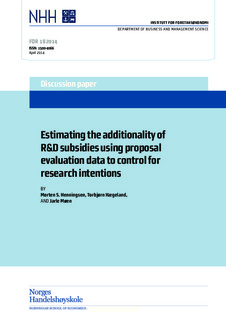| dc.description.abstract | Empirical examination of whether R&D subsidies crowd out private investments has been hampered
by selection problems. A particular worry is that project quality and research intentions may be correlated with
the likelihood of receiving subsidies. Using proposal evaluation data to control for research intentions, we do
not find strong evidence suggesting that this type of selection creates a severe bias. Proposal evaluation grades
strongly predict R&D investments and reduce selection bias in cross‐sectional regressions, but there is limited
variation in grades within firms over time. Hence, in our sample, unobserved project quality is largely absorbed
by firm fixed effects. Our best estimate of the short‐run additionality of R&D subsidies is 1.15, i.e., a one‐unit
increase in subsidy increases total R&D expenditure in the recipient firm by somewhat more than a unit. We
demonstrate, however, that there is measurement error in the subsidy variable. Additionality is therefore likely
to be underestimated. | nb_NO |
